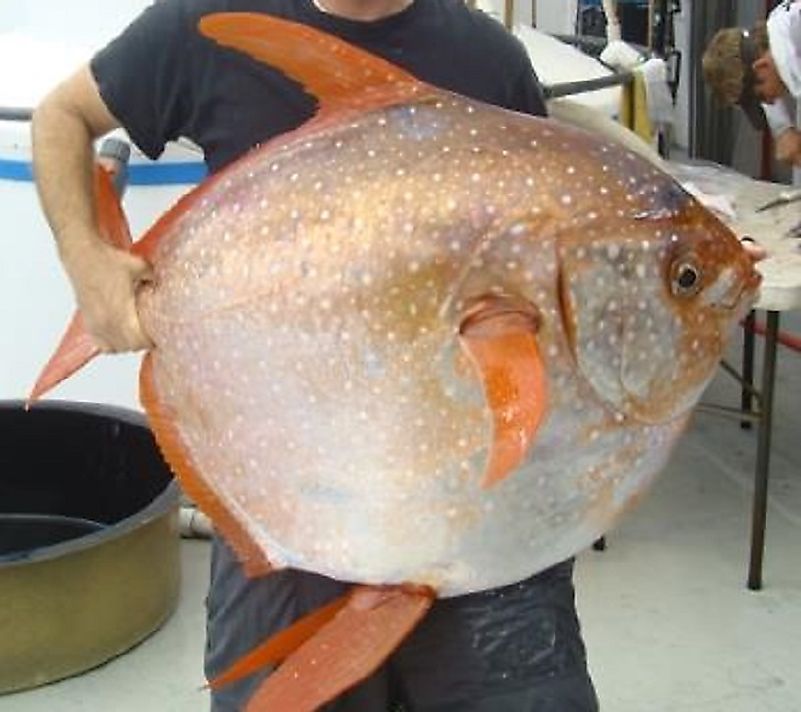What Do You Know About Opah, The Warm-Blooded Fish?

5. Physical Description
The opah (Genus Lampris), also variously known as the moonfish or kingfish among other names, refers to a large, round, and colorful fish found in the pelagic zones of the oceans. These fish possess strikingly beautiful coloration with a reddish-orange-silver graded color pattern on the body, and crimson-colored fins. Small white spots also cover the flanks of the body, while the large eyes are surrounded by a golden yellow ring. The snout of the opah is pointed, and it bears a small, terminal, toothless mouth. Two species of opahs belonging to the genus Lampris survive today. Namely, these are the Lampris guttatus and the Lampris immaculatus, with the former being the larger species of the two. The former can achieve a length of up to 6.6 feet, while the latter is only about 3.6 feet in length.
4. Ecological Role
In the waters of the ocean, the opahs, like all other marine aquatic species, play an important ecological role by being an important member of the food chain of the sea-water ecosystem. The opahs feed on large volumes of krills and squids and often also include several species of small fish as part of their diet. The opahs in turn, serve as the prey for large species of sharks like the mako sharks and the great white sharks. Thus, by being an inherent part of the food chain in the oceans, the opahs help maintain the stability of the marine water ecosystem.
3. Significance to the Fishing Industry
Opahs are savored as a delicacy in many parts of the world and in Hawaii many restaurants serve Opah preparations on the menu. These fish are also highly utilized for sushi and sashimi preparations. The delectable taste of these fish thus creates a big demand for them in the market, encouraging the fishing industry to engage in commercial fishing operations to catch the opahs. These fish are also often caught as bycatch fish during commercial fishing for tuna. Recreational fishermen also aim to catch the opahs as the opahs have high taxidermy value. The eye-catching colors, size and shape of this fish increases its value as a trophy fish.
2. Habitat and Range
The two species of opahs exhibit distinct distribution patters. While the Lampris guttatus has an extremely wide range, the Lampris immaculatus is only confined to the Southern Ocean with the 34° South latitude forming its northernmost boundary, and the Atlantic Polar Front forming its southern limitation. The Lampris guttatus is however, distributed across most major oceans of the world and is found in the waters of the West Atlantic as well as the East Atlantic, the East Pacific, the Indian Ocean, and also the Southern Ocean. In the East Atlantic, the fish inhabit the waters of the ocean stretching from Norway in the north to Angola in the south. In the Eastern Pacific, the range of the opah stretches all the way from the Gulf of Alaska down south into the coastal waters of California.
1. Unique Physiological Characteristics
In nature, mammals and birds are traditionally known to be endothermic or warm-blooded, possessing the ability to keep their body warm even when surrounding temperatures drop below their mean body temperature. Meanwhile other classes of animals like fishes are considered to be cold-blooded, wherein they are always at the mercy of the surrounding temperatures as they cannot regulate their own body temperatures. However, the opahs are the only known fish that are warm-blooded in nature. This property of the opahs allows them to retain a warm body temperature, about 5 degrees Celsius higher than the temperature of the surrounding water, facilitating their fast movements in deep waters in search of prey. Scientists found that the opahs, like most other fishes, propelled forward in the water by rapidly flapping their pectoral wings to generate warmth and energy. This was, however, unable to explain the real reason for the warm-blooded feature of these fish. When scientists further delved into the physiological details of the fish, they made an exciting discovery. They found that the gills of these fish are unlike any other fish gills observed so far. The blood vessels in the gills are uniquely arranged, where the vessels carrying warm, deoxygenated blood from the body to the gills remain in contact with the vessels carrying the cold, oxygenated blood from the gills to the body. This contact between the vessels allows for the exchange of heat between them, thus triggering an increase in temperature of the blood entering the body from the gills, keeping the opah warm in spite of the cooler surrounding water temperatures.











